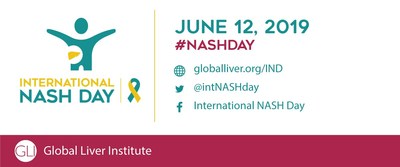WASHINGTON, June 12, 2019 /PRNewswire/
-- Nonalcoholic Steatohepatitis (NASH) is a potentially
fatal condition affecting up to 12% of adults worldwide, an
estimated 115 million people around the globe, yet in a recent
survey, only 6% of at-risk individuals had ever heard of the
condition. Leaders in liver health advocacy, The Global Liver
Institute (GLI) is declaring NASH a "hidden epidemic," marking
June 12th as
International NASH Day to shine a spotlight on NASH and raise
awareness of the little-known symptoms of this disease and the need
for better diagnosis and treatment options.

On International NASH Day, GLI is coordinating dozens of
organizations and events worldwide to educate on this disease and
advocate for patients who have and are at risk for NASH. NASH is
the progressive form of nonalcoholic fatty liver disease (NAFLD)
and approximately 20% of NAFLD patients develop NASH.1
NASH is where fat globules accumulate in liver cells, leading to
cell death and the development of inflammation. With years of
chronic inflammation, scar tissue begins to form and cause liver
fibrosis and when fibrosis is severe, it becomes cirrhosis, which
can result in liver failure and liver cancer. The only cure for
NASH cirrhosis at this time is a liver transplant. NAFLD and NASH
are major risk factors for other health conditions: more than 70%
of patients are obese, up to 75% have type 2 diabetes, and anywhere
from 20-80% have
hyperlipidemia.
"We feel an urgent need to raise awareness for and educate on
nonalcoholic fatty liver disease and nonalcoholic steatohepatitis
so that these liver diseases are included in every healthcare
conversation when obesity and diabetes are mentioned," says
Donna R. Cryer, JD, President and
CEO, Global Liver Institute. "We are spearheading a global
effort for adoption of non-invasive tests so that early detection
and diagnosis of these diseases is easier and we can begin to stem
the tide of this global epidemic."
NASH is poorly-known, under-diagnosed, and as such represents a
growing global public health issue in most countries including the
United States. Approximately 30 million Americans have NASH
and the prevalence is expected to increase by 63% by 2030 in
association with increased obesity and type 2 diabetes.
Despite its prevalence, there is still a lot more work to be
done to properly address NAFLD and NASH. GLI and its partners are
working to not only stem the tide of this rapidly increasing
epidemic but reverse it. A major focus of IND is to promote early
intervention and make sure that all populations at risk for
developing NASH know to talk to their doctor about getting
screened. GLI has developed a complementary campaign called Beyond
the Biopsy to accelerate acceptance and adoption of non-invasive
technologies as an alternative to biopsy, so more people can be
screened and diagnosed before they develop NASH.
About GLI
Global Liver Institute is a 501(c)(3) tax-exempt not-for-profit
organization, headquartered in Washington, D.C., United States.
GLI's vision is for liver health to take its place on the global
public health agenda commensurate with its prevalence and impact.
GLI's mission is to improve the impact of the liver community by
promoting innovation, collaboration, and scaling optimal approaches
to eradicating liver diseases. GLI is the global host of
International NASH Day.
For more information on GLI, visit www.GlobalLiver.org, Follow
us on Twitter @GlobalLiver or Facebook at
www.facebook.com/GlobalLiver.
For more information on International NASH Day go to
www.globalliver.org/ind or lend your support on social media
using hashtag #NASHday.
1 Spengler EK, Loomba R. Recommendations for
diagnosis, referral for liver biopsy, and treatment of nonalcoholic
fatty liver disease and nonalcoholic steatohepatitis. Mayo Clinic
Proceedings. 2015;90(9):1233–1246.
 View original content to download
multimedia:http://www.prnewswire.com/news-releases/gli-declares-new-global-public-health-epidemic-in-light-of-startling-lack-of-awareness-300866035.html
View original content to download
multimedia:http://www.prnewswire.com/news-releases/gli-declares-new-global-public-health-epidemic-in-light-of-startling-lack-of-awareness-300866035.html
SOURCE Global Liver Institute